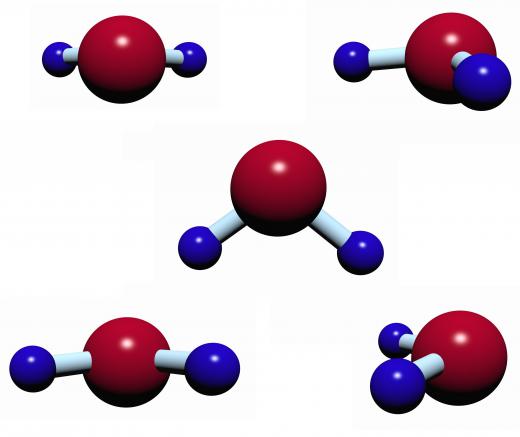At AllTheScience, we're committed to delivering accurate, trustworthy information. Our expert-authored content is rigorously fact-checked and sourced from credible authorities. Discover how we uphold the highest standards in providing you with reliable knowledge.
What Is a Polar Solvent?
A polar solvent is a liquid with molecules that have a slight electrical charge due to its shape. For example, water is a molecule with one oxygen and two hydrogen atoms. The two hydrogen atoms are not on opposite sides of the oxygen, but rather at an angle. This creates a slight imbalance of the electrical charge in the water molecule, also known as polarity.
When a solid molecule is placed in a polar solvent, it may dissolve if it has polarity of its own. This occurs because the molecules of the solid are attracted to the weak electrical charges of the solvent. Examples of polar materials include salt and sugar, both of which dissolve easily in water, the Earth's most common polar solvent.

A polar solvent will not normally dissolve non-polar materials, or vice versa. Salt and sugar will not dissolve in most organic solvents, because there is no electrical charge to attract the molecules. The term "like prefers like" is often used to note the preference of polar materials for polar solvents, and similarly for non-polar materials. There are some rare exceptions to this rule, because non-polar solvents may have slight electrical charges that can imitate polar ones.

When a solid is placed in a solvent and dissolves, the solid molecules are dispersed or spread evenly in the solvent. This dissolved mixture will remain stable as long as enough solvent remains to surround the solid molecules. Precipitation, or separation of solid from the mixture, can occur if there is more solid present than can be dissolved. These solutions are called saturated, and changes in temperature can cause solid to precipitate from the dissolved mixture.
A polar solvent is often classified by stating its dielectric constant or polarity index. Dielectric constant is a measurement of the electrical properties of a solvent in a sample versus an empty capacitor, which holds the material while electrical current passes through it. Polar index is a relative measurement of a solvent's ability to dissolve various standard polar materials. In both tests, the measured constant or index is placed in a table of common solvents, which can be used for identifying solvents for chemical processes.
Another type of solvent, a surfactant, can be used to create mixtures of polar and non-polar materials. Surfactants are molecules that are polar and non-polar on each end. These materials will create molecular bonds of the polar end with similar molecules, and similarly with the non-polar end.
An example of this effect is hand cream. Water and oily moisturizers normally do not mix, and if shaken will eventually separate. Adding a surfactant causes the two non-soluble materials to form a stable emulsion. The oil and water are not dissolved, because they are not soluble in each other, being polar and non-polar. A surfactant bonds the two materials and they remain stable emulsions for long periods.
AS FEATURED ON:
AS FEATURED ON:












Discussion Comments
Thanks for this. Water has been described by some chemists as a "universal solvent." This article explains why.
Post your comments